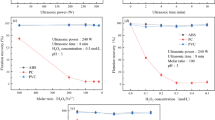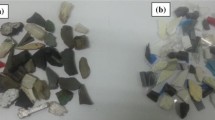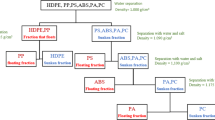Abstract
We have developed the hybrid jig which combines the principles of jig separation and flotation. However, the selectivity of bubble attachment in water was poor because most plastics have inherently hydrophobic surfaces; so, development of surface modification techniques for plastic particles would expand the application of hybrid jig to the material recycling of plastics. In this study, hybrid jig separation of polypropylene using glass fiber and high impact polystyrene having similar specific gravities and surface wettability were investigated with three wetting agents [Di-2-ethylhexyl sodium sulfosuccinate (Aerosol OT, AOT), sodium lignin sulfonate, and tannic acid]. The results showed that the probability of bubble attachment was influenced by wetting agents because of their strong effects on the surface tension of solution and surface wettability of plastics. The results also suggest that wetting agents could be utilized to control the selectivity of bubble attachment and improve the hybrid jig separation efficiency. In addition, since the hybrid jig separation of polyvinyl chloride and polyamide (nylon-66) using AOT was imperfect, a two-step approach, composed of a pre-wetting step (first step) in a solution containing the wetting agent (AOT) and hybrid jig separation in water (second step), is proposed.






Similar content being viewed by others
References
Statista (2019) Global plastic production from 1950 to 2017 (in million metric tons). https://www.statista.com/statistics/282732/global-production-of-plastics-since-1950. Accessed 15 Apr 2018
PlasticsEurope (2018) Plastics—the facts 2018. An analysis of European plastics production, demand and waste data. https://www.plasticseurope.org/application/files/6315/4510/9658/Plastics_the_facts_2018_AF_web.pdf. Accessed 22 Apr 2019
Tsunekawa M, Naoi B, Ogawa S, Hori K, Hiroyoshi N, Ito M, Hirajima T (2005) Jig separation of plastics from scrapped copy machines. Int J Miner Process 76:67–74. https://doi.org/10.1016/j.minpro.2004.12.001
Hori K, Tsunekawa M, Hiroyoshi N, Ito M (2009) Optimum water pulsation of jig separation for crushed plastic particles. Int J Miner Process 92:103–108. https://doi.org/10.1016/j.minpro.2009.01.001
Hori K, Tsunekawa M, Ueda M, Hiroyoshi N, Ito M, Okada H (2009) Development of a new gravity separator for plastics—a Hybrid-jig. Mater Trans 50:2844–2847. https://doi.org/10.2320/matertrans.M-M2009825
Ito M, Tsunekawa M, Ishida E, Kawai K, Takahashi T, Abe N, Hiroyoshi N (2010) Reverse jig separation of shredded floating plastic-separation of polypropylene and high density polyethylene. Int J Miner Process 97:96–99. https://doi.org/10.1016/j.minpro.2010.08.007
Kuwayama Y, Ito M, Hiroyoshi N, Tsunekawa M (2011) Jig separation of crushed automobile shredded residue and its evaluation by float and sink analysis. J Mater Cycles Waste Manag 13:240–246. https://doi.org/10.1007/s10163-011-0008-y
Tsunekawa M, Kobayashi R, Hori K, Okada H, Abe N, Hiroyoshi N, Ito M (2012) Newly developed discharge device for jig separation of plastics to recover higher grade bottom layer product. Int J Miner Process 114–117:27–29. https://doi.org/10.1016/j.minpro.2012.09.003
Phengsaart T, Ito M, Hamaya N, Tabelin CB, Hiroyoshi N (2018) Improvement of jig efficiency by shape separation, and a novel method to estimate the separation efficiency of metal wires in crushed electronic wastes using bending behavior and “entanglement factor”. Miner Eng 129:54–62. https://doi.org/10.1016/j.mineng.2018.09.015
Pita F, Castilho A (2016) Influence of shape and size of the particles on jigging separation of plastics mixture. Waste Manag 48:89–94. https://doi.org/10.1016/j.wasman.2015.10.034
Ferrara G, Bevilacqua P, Lorenzi L, Zanin M (2000) The influence of particle shape on the dynamic dense medium separation of plastics. Int J Miner Process 59:225–235. https://doi.org/10.1016/S0301-7516(99)00078-2
Pongstabodee S, Kunachitpimol B, Damronglerd S (2008) Combination of three-stage sink-float method and selective flotation technique for separation of mixed post-consumer plastic waste. Waste Manag 28:475–483. https://doi.org/10.1016/j.wasman.2007.03.005
Richard GM, Mario M, Javier T, Susana T (2011) Optimization of the recovery of plastics for recycling by density media separation cyclones. Resour Conserv Recycl 55:472–482. https://doi.org/10.1016/j.resconrec.2010.12.010
Dodbiba G, Shibayama A, Sadaki J, Fujita T (2003) Combination of triboelectrostatic separation and air tabling for sorting plastics from a multicomponent plastic mixture. Mater Trans 44:2427–2435. https://doi.org/10.2320/matertrans.44.2427
Dodbiba G, Sadaki J, Okaya K, Shibayama A, Fujita T (2005) The use of air tabling and triboelectric separation for separating a mixture of three plastics. Miner Eng 18:1350–1360. https://doi.org/10.1016/j.mineng.2005.02.015
Gente V, Marca FL, Lucci F, Massacci P (2003) Electrical separation of plastics coming from special waste. Waste Manag 23:951–958. https://doi.org/10.1016/S0956-053X(03)00088-6
Shent H, Pugh RJ, Forssbergc E (1999) A review of plastics waste recycling and the flotation of plastics. Resour Conserv Recycl 25:85–109. https://doi.org/10.1016/S0921-3449(98)00017-2
Fraunholcz N (2004) Separation of waste plastics by froth flotation—a review, part I. Miner Eng 17:261–268. https://doi.org/10.1016/j.mineng.2003.10.028
Wang C, Wang H, Fu J, Liu Y (2015) Flotation separation of waste plastics for recycling—a review. Waste Manag 41:28–38. https://doi.org/10.1016/j.wasman.2015.03.027
Güney A, Özdilek C, Kangal MO, Burat F (2015) Flotation characterization of PET and PVC in the presence of different plasticizers. Sep Purif Technol 151:47–56. https://doi.org/10.1016/j.seppur.2015.07.027
Burat F, Güney A, Kangal MO (2009) Selective separation of virgin and post-consumer polymers (PET and PVC) by flotation method. Waste Manag 29:1807–1813. https://doi.org/10.1016/j.wasman.2008.12.018
Shibata J, Matsumoto S, Yamamoto H, Lusaka E, Pradip (1996) Flotation separation of plastics using selective depressants. Int J Miner Process 48:127–134. https://doi.org/10.1016/S0301-7516(96)00021-X
Marques GA, Tenório JAS (2000) Use of froth flotation to separate PVC/PET mixtures. Waste Manag 20:265–269. https://doi.org/10.1016/S0956-053X(99)00333-5
Saisinchai S (2013) Separation of PVC from PET/PVC mixtures using flotation by calcium lignosulfonate depressant. Eng J 18:45–54. https://doi.org/10.4186/ej.2014.18.1.45
Wang H, Wang C, Fu J, Gu G (2014) Flotability and flotation separation of polymer materials modulated by wetting agents. Waste Manag 34:309–315. https://doi.org/10.1016/j.wasman.2013.11.007
Pita F, Castilho A (2017) Separation of plastics by froth flotation. The role of size, shape and density of the particles. Waste Manag 60:91–99. https://doi.org/10.1016/j.wasman.2016.07.041
Takoungsakdakun T, Pongstabodee S (2007) Separation of mixed post-consumer PET–POM–PVC plastic waste using selective flotation. Sep Purif Technol 54:248–252. https://doi.org/10.1016/j.seppur.2006.09.011
Dodbiba G, Haruki N, Shibayama A, Miyazaki T, Fujita T (2002) Combination of sink–float separation and flotation technique for purification of shredded PET-bottle from PE or PP flakes. Int J Miner Process 65:11–29. https://doi.org/10.1016/S0301-7516(01)00056-4
Jeon S, Ito M, Tabelin CB, Pongsumrankul R, Kitajima N, Hiroyoshi N (2018) Gold recovery from shredder light fraction of E-waste recycling plant by flotation-ammonium thiosulfate leaching. Waste Manag 77:195–202. https://doi.org/10.1016/j.wasman.2018.04.039
Wills BA, Napier-Munn TJ (2006) Mineral processing technology, 7th edn. Pergamon Press, Oxford
Brozek M, Surowiak A (2007) Effect of particle shape on jig separation efficiency. Physicochem Probl Miner Process 41:397–413
Beunder EM (2000) Influence of shape on particle behaviour in recycling techniques. Dissertation, Delft University of Technology
Boylu F, Cinku K, Cetinel T, Karakas F, Guven O, Karaagaclioglu IE, Celik MS (2015) Effect of coal moisture on the treatment of a lignitic coal through a semi-pilot-scale pneumatic stratification jig. Int J Coal Prep Util 35:143–153. https://doi.org/10.1080/19392699.2015.1005743
Butt HJ, Graf K, Kappl M (2003) Physics and chemistry of interfaces, 1st edn. Wiley, Weinheim
Firouzi M, Nguyen AV, Hashemabadi SH (2011) The effect of microhydrodynamics on bubble-particle collision interaction. Miner Eng 24:973–986. https://doi.org/10.1016/j.mineng.2011.04.005
Zhao Y, Li YP, Huang J, Liu J, Wang WK (2015) Rebound and attachment involving single bubble and particle in the separation of plastics by froth flotation. Sep Purif Technol 144:123–132. https://doi.org/10.1016/j.seppur.2015.02.016
Acknowledgements
The authors gratefully acknowledge the JSPS KAKENHI 23560990 for financial support and wish to thank Prof. Toshiaki Yoshioka, Prof. Shinichi Sakai, and the anonymous reviewers for their valuable inputs to this paper.
Author information
Authors and Affiliations
Corresponding author
Additional information
Publisher's Note
Springer Nature remains neutral with regard to jurisdictional claims in published maps and institutional affiliations.
Rights and permissions
About this article
Cite this article
Ito, M., Takeuchi, M., Saito, A. et al. Improvement of hybrid jig separation efficiency using wetting agents for the recycling of mixed-plastic wastes. J Mater Cycles Waste Manag 21, 1376–1383 (2019). https://doi.org/10.1007/s10163-019-00890-w
Received:
Accepted:
Published:
Issue Date:
DOI: https://doi.org/10.1007/s10163-019-00890-w




